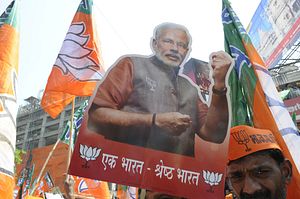Having formally been elected by the Bharatiya Janata Party-led National Democratic Alliance (NDA) coalition, Narendra Modi will be sworn in as the next Prime Minister of India. On Tuesday, Prime Minister-elect Modi issued invitations to the leaders of India’s neighbors — members of the South Asian Association for Regional Cooperation (SAARC) — to his ceremony, as a gesture demonstrating that he is interested in engaging India with the surrounding region. Modi will be sworn in as India’s 15th Prime Minister on May 26. He will be the first Indian prime minister to have been born after India’s independence in 1947.
According to NDTV, Afghan President Hamid Karzai, who is bound to leave office soon following Afghanistan’s run-off presidential elections, has confirmed that he will attend Modi’s swearing in. In the final days of the Congress Party-led United Progressive Alliance (UPA) government in New Delhi, Karzai regularly asked for Indian aid and support as U.S. and NATO troops prepare to withdraw from his country, leaving a somewhat uncertain security situation behind. Karzai’s presence will likely reinforce Afghanistan’s interest in working with Modi. Both of Karzai’s likely successors, Ashraf Ghani and Abdullah Abdullah, are highly pro-India and would pursue the same sort of agenda that Karzai established.
Additionally, Sri Lanka’s President Mahinda Rajapaksa has confirmed his attendance. Having Rajapaksa in attendance will likely prove controversial with certain South Indian regional parties who hold his government responsible for atrocities against ethnic Tamils during Sri Lanka’s civil war. During the last Indian government, tensions between the central government and these regional parties made progress on bilateral relations between the two countries a controversial affair. It remains to be seen if Modi will be able to exercise pragmatism on the Sri Lanka issue while still managing to cooperate with the increasingly powerful southern regional parties, such as Jayalalithaa’s All India Anna Dravida Munnetra Kazhagam (AIADMK).
Responses from other leaders, including Pakistan’s Nawaz Sharif, are yet to come in. It is difficult to imagine Sharif attending Modi’s swearing-in. While the move would symbolically speak to Sharif’s government’s sincerity in looking to a “new beginning” with India under Modi, it appears to be politically infeasible at this time. Last year, following Sharif’s election in Pakistan, Indian Prime Minister Manmohan Singh declined an invitation to travel to Islamabad to witness his swearing-in. Sharif declining Modi’s invitation could be a form of reciprocity.
The decision to invite SAARC leaders in and of itself speaks to the BJP’s and Modi’s often obscured foreign policy agenda. Modi, who campaigned on a platform of good governance and economic growth, will look to boost India’s economy by deepening ties with its neighbors and ideally elevating India to the role of a regional leader within the somewhat moribund SAARC institutional framework. Reaching out to India’s neighbors at this time is thus a sensible strategy. According to India’s Economic Times, the decision to invite SAARC leaders was taken by Modi himself — not by the party or the Ministry of External Affairs.
The SAARC counts Afghanistan, Bangladesh, Bhutan, India, Maldives, Nepal, Pakistan, and Sri Lanka as its eight members. A small group of countries have observer status including Australia, China, Iran, Japan, South Korea, and the United States.

































